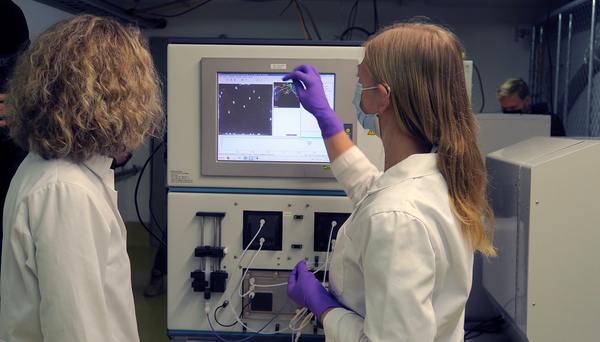News Detail
Early detection for wastewater treatment plants
June 17, 2025 |
The quality of surface waters is under various forms of pressure as we use more and more chemicals that find their way into water bodies one way or another. This makes the role of wastewater treatment plants (WWTPs), where most wastewater flows are treated before being discharged into water bodies, all the more important. The expansion of many WWTPs with an additional treatment stage has led to a significant improvement in the removal of micropollutants. Nevertheless, the quality of the wastewater must be constantly monitored in order to detect incidents and react as quickly as possible.
Traditional monitoring methods using random or pooled samples reach their limits when it comes to detecting concentration peaks at short notice or reacting promptly to potentially critical substances. The composition of wastewater can change very quickly, especially in the case of industrial discharges. Extreme rainfall and temperature fluctuations can also affect treatment performance. All this can lead to the quality of the treated wastewater no longer being guaranteed.
Biological early warning systems – also known as online biomonitoring – offer a possible solution. These systems use aquatic organisms to continuously monitor the biological effect of substances in wastewater in real time. If such methods are combined with continuous chemical analysis, this enables a holistic assessment of water quality and the potential toxic effects of micropollutants.
An array of biological early warning systems
In biological early warning systems, test organisms react to pollution in the tested water with measurable changes in a metabolic process or behaviour. If this change, which is continuously monitored, exceeds a threshold value, an alarm is triggered. Various organisms are used as sensors, such as bacteria, algae, small crustaceans or fish. Suitable measurement parameters include the photosynthetic activity of algae or the swimming behaviour and respiration of crustaceans and fish, which can be influenced by pollutants.
As all organisms react differently to micropollutants, there is no single test organism that reliably detects all pollutants. An array of different systems is therefore ideal. The team led by Ali Kizgin, who investigated this topic in his doctoral thesis at the Ecotox Centre together with researchers from the Eawag aquatic research institute and the University of Applied Sciences Northwestern Switzerland, selected three test systems. Firstly, a monocellular green alga, in which photosynthetic activity is observed by continuously measuring fluorescence. Secondly, two freshwater crustaceans, namely water fleas and freshwater amphipods, whose swimming behaviour and activity are monitored by cameras and motion sensors.
Combination with online chemical analysis
“If you combine the biomonitors with high-resolution chemical analysis, it becomes possible to confirm biological alarms and find out which substance was responsible for the measured reaction,” explains Ali Kizgin. “We were in an ideal situation, as Eawag had just developed the MS2field – one of the first mobile measurement platforms that makes it possible to measure micropollutants in environmentally relevant concentrations continuously and with high temporal resolution in the field.”
However, it is not easy to link the occurrence of chemical substances to behavioural responses, as other environmental factors can also lead to false positive alarms. For this reason, a number of physical-chemical parameters in the wastewater were monitored in parallel. The combination of biological and chemical early warning systems was subjected to thorough testing over five weeks at a municipal wastewater treatment plant in the canton of St. Gallen.
Toxic events are checked
“During the course of the experiment, the biological early warning systems actually issued us an alarm several times,” reports Ali Kizgin. The systems with water fleas and freshwater shrimps reacted more sensitively than the system with green algae.
“When an alarm was triggered, we checked whether the detected micropollutants were present in concentrations that were high enough to be toxic,” says Kizgin. “If this was the case, we carried out additional experiments in the laboratory to check whether a specific chemical was responsible for the biological reaction.”
In the system with freshwater shrimps, two significant alarms were triggered during the test period. In the first alarm, the creatures were suddenly much more active than before, following heavy rainfall. However, chemical monitoring did not detect any relevant toxic substances. As the water temperature dropped by two degrees at the same time due to the rain event, this probably influenced the behaviour of the amphipods.
In the second alarm, the MS2field was able to detect the insecticide carbofuran, a pesticide that is banned in Switzerland and can have a toxic effect on aquatic invertebrates. Further laboratory tests confirmed that carbofuran was very likely the cause of the alarm observed.
A valuable approach to wastewater management
The study shows that the combination of online biological monitoring with high-resolution chemical monitoring represents a valuable approach for detecting peak loads of micropollutants in wastewater treatment plants in real time. “After successfully testing the method in municipal wastewater, it is now ready for use in an industrial wastewater treatment plant,” says Ali Kizgin. “It can also be used to identify harmful substances that are present in complex industrial wastewater and which cannot be detected using conventional monitoring methods.”
This text is an abridged version of the more detailed information on the website of the Ecotox Centre.
Cover picture: Treated wastewater can be continuously monitored using online monitoring with organisms. The data obtained in this way makes it possible to respond quickly to acute stress. (Photo: Ecotox Centre)
Original publication
Financing / Cooperations
- Eawag
- Ecotox Centre
- University of Applied Sciences Northwestern Switzerland

